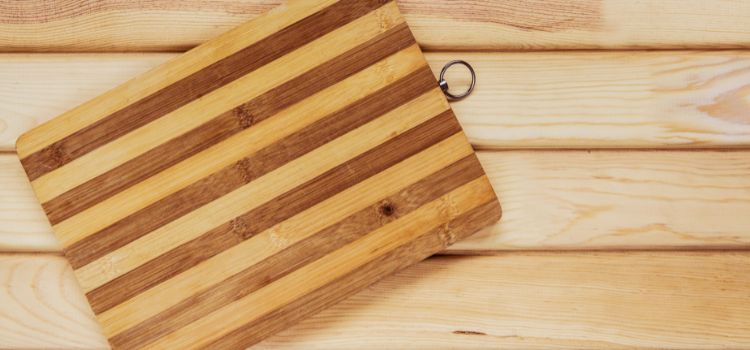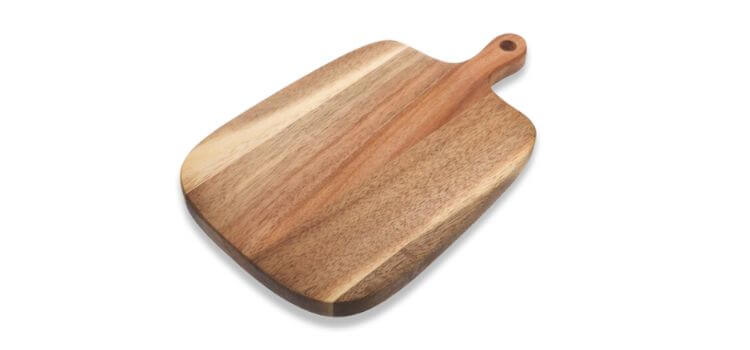As an Amazon Associate, I earn from qualifying purchases

Linseed oil, derived from the seeds of the flax plant, has been used for centuries in various applications, ranging from wood finishing to nutritional supplements. Its ability to penetrate wood and provide a protective layer makes it an attractive option for preserving wooden surfaces.
In the world of kitchen maintenance, oiling cutting boards is crucial. It prevents the wood from drying out, cracking, and warping, ensuring that your board remains a reliable surface for food preparation.
Benefits of Using Linseed Oil on Cutting Boards
- Natural Finish and Protective Qualities: Linseed oil is cherished for its natural finish. When applied to a cutting board, it seeps into the wood pores, enhancing the grain’s natural beauty and providing a protective barrier against moisture. This protection is crucial for maintaining the board’s structural integrity, especially in a kitchen environment where exposure to water is frequent.
- Enhancing Wood Grain Appearance: One of linseed oil’s most appealing qualities is its ability to bring out the wood’s natural grain, giving your cutting board a rich, lustrous appearance. This aesthetic enhancement can transform a simple kitchen tool into a centerpiece that adds warmth and character to your culinary space.
- Longevity of Surface Protection: With regular application, linseed oil can offer long-term protection for your cutting board. It helps to prevent the wood from becoming brittle and supports its resistance to daily wear and tear. This longevity means your board will not only look good but also perform well for years to come.
Potential Drawbacks of Linseed Oil
- Risk of Rancidity and Odor Development: One concern with using linseed oil is its tendency to become rancid over time. This can result in an unpleasant odor, especially if the oil used is not food-grade. It’s crucial to ensure that any linseed oil applied to a cutting board is specifically manufactured for culinary use to avoid this issue.
- Comparisons with Food-Safe Mineral Oil: Mineral oil is often recommended for cutting boards due to its food-safe nature and resistance to rancidity. Unlike linseed oil, mineral oil does not harden over time, making it a reliable option for those concerned about odor development and safety.
- Effects on Different Types of Wood: The effectiveness of linseed oil can vary depending on the type of wood used for your cutting board. Some woods may absorb the oil more readily, while others might require more frequent applications to achieve the desired level of protection and finish.
Comparison with Other Oils
Mineral Oil: Safety and Availability
Mineral oil is a staple in cutting board care due to its availability and safety. It’s odorless, tasteless, and does not go rancid, making it a worry-free option for many. Its main disadvantage is that it doesn’t enhance the wood’s appearance as much as linseed oil.
Coconut Oil: Antibacterial Properties and Downsides
Coconut oil is another popular choice, known for its antibacterial properties. However, it can also become rancid over time, and some users find it leaves a residue. Its solid state at room temperature can also make application more challenging.
Walnut Oil: Hypoallergenic Considerations
Walnut oil is praised for its hypoallergenic properties, making it suitable for households with nut allergies. It provides a robust finish but can be more expensive than other oils. Like linseed oil, ensuring it doesn’t go rancid is important.
Application Process

Steps for Applying Linseed Oil to a Cutting Board
- Clean the Board: Ensure the board is clean and completely dry before application. Any moisture can inhibit oil absorption.
- Apply the Oil: Pour a small amount of linseed oil onto the board and use a cloth or paper towel to spread it evenly across the surface. Make sure to cover all areas, including the edges.
- Allow Absorption: Let the oil soak into the wood for several hours or overnight.
- Wipe Excess: After soaking, wipe away any excess oil with a clean cloth to prevent stickiness.
Frequency of Application for Optimal Results
For best results, apply linseed oil once a month or whenever the board starts to look dry. More frequent application may be necessary for new boards or those subjected to heavy use.
Tips for Achieving an Even Finish
Work in small sections to ensure the oil is evenly distributed. Use circular motions to penetrate the wood grain and avoid over-saturating any area.
Safety Considerations
- Ensuring the Use of Food-Grade Linseed Oil: Always choose food-grade linseed oil for cutting board applications to ensure safety. This type of oil is specifically processed to prevent harmful substances from contaminating food.
- Managing Allergic Reactions and Sensitivities: Be cautious if anyone in your household has allergies or sensitivities to linseed or flaxseed products, as this could pose a health risk.
- Storage and Handling Precautions: Store linseed oil in a cool, dark place to prolong its shelf life. Proper storage helps prevent rancidity and ensures the oil remains effective for future applications.
Maintaining a Cutting Board with Linseed Oil
- Routine Cleaning and Care Practices: Regularly clean your cutting board with mild soap and water. Avoid soaking it in water and dry it immediately to prevent warping.
- Signs It’s Time to Reapply Oil: If the wood appears dry, faded, or starts to absorb liquids rather than repelling them, it’s time to reapply linseed oil.
- Long-Term Care Tips for Wooden Cutting Boards: Avoid using harsh detergents or abrasive cleaning tools. Store the board upright to ensure even drying and prevent moisture buildup on one side.
Conclusion
Linseed oil offers a natural and effective way to maintain and enhance wooden cutting boards. While it provides a beautiful finish and robust protection, considerations about potential rancidity and the need for food-grade options are essential. When compared to other oils like mineral and coconut oil, the choice ultimately depends on personal preferences and priorities.
For those who appreciate the aesthetic appeal and are diligent with maintenance, linseed oil can be a worthy addition to your kitchen care routine, ensuring your cutting board remains a beloved part of your culinary adventures.
FAQ
Is linseed oil food safe?
Linseed oil can be food safe, but it’s crucial to use the food-grade variety for cutting boards to avoid harmful chemicals found in non-food-grade versions. Food-grade linseed oil is specially processed to ensure safety when in contact with food, preventing contamination and providing a safe finish.
What kind of oil is good for cutting boards?
Mineral oil is highly recommended for cutting boards due to its food-safe properties, affordability, and resistance to rancidity. Other options include walnut oil, which is hypoallergenic, and food-grade linseed oil for its natural finish. Each choice depends on personal preferences and specific board needs.
How many coats of linseed oil on a cutting board?
Typically, two to three coats of linseed oil are sufficient for a cutting board. Start with one coat, allowing it to soak overnight, then apply additional layers as needed. The board should be well-saturated but not sticky. Regular maintenance ensures optimal protection and appearance.
As an Amazon Associate, I earn from qualifying purchases